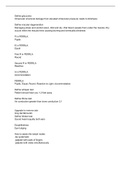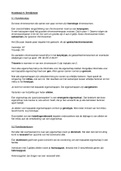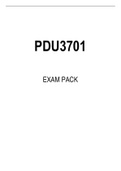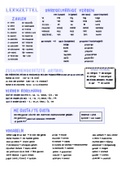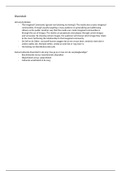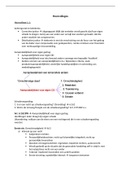MNO2603
EXAM
PACK 2023
, Safety Management mno2603
STUDY UNIT 1
INTRODUCTION TO SAFETY MANAGEMENT
1.1 Introduction
Managing safety in all contexts of life requires specific knowledge, skills and intentions in
order to prevent
unsafety and ensure safety. Unsafety implies harm to people or damage to property,
equipment, business
operations, natural environment or environmental ecosystems.
1.2 Historical developments before the Industrial Revolution
(i) Code of Hammarubi
This code introduced the practice of noticing and dealing with injuries in the
workplace.
Payments were made to physicians who treated such injuries, while workers who
injured others
were charged financially or punished on an eye-for-eye basis.
(ii) Rameses II
Rameses introduced an industrial medical service for workers, regular cleansing of
workers by
bathing in the Nile River and isolating injured workers.
(iii) Romans
The Romans improved the general quality of life and workplace standards by
building aqueducts,
sewerage systems, public baths, latrines and ventilated houses.
1.2.1 Employer liability
During Industrial Revolution, no prescriptions governing safe working conditions existed. In
the second half of
the 19th century, laws for making the workplace safe were passed. These laws introduced
employer liability
and government inspection programmes to oversee their implementation.
1.2.2 Making equipment safer
During the late 19t century, efforts to enhance safety in the workplace took a different
form. The use of child
labour declined and was later abolished. Safety measures for the design and maintenance of
different types of
machines became a legal requirement. Fire escapes became mandatory.
1.2.3 Employee compensation
This legislation determined that an employer’s compensation to the injured employee did
not depend on whether either party had been negligent or not. The assumption was that
both parties were jointly responsible.
,1.2.4 Safety regulations and inspections
The second half of the 20th century saw a drastic increase in government regulations
pertaining to security. The compliance with legislation set a clear direction for ensuring
safety in the workplace. Government inspections of focused on identifying and rectifying
faults.
1.2.5 The need for training in safety management
Understanding and providing the cause of an accident was difficult in the late 19th century.
The high frequency of accidents resulted in the need for extensive training in all aspects of
safety in all types of work. Formal academic university courses along with informal, basic
safety problem-solving courses were introduced.
1.3 Safety hazards, safety management and safety risks
1.3.1 Nature of safety hazards
For something to be a safety hazard, it must be tangible. If it is, the safety hazard will consist
of matter and can interact with other things, and is thus capable of damage. Once
something is classified as a safety hazard, it will always be a safety hazard. For this reason,
there is no such thing as a potential safety hazard.
1.3.2 Characteristics of safety hazards
Structural characteristics
• Tangibility – based on the material having mass, meaning that physical contact can
be made with it.
• Density – forms the basis of solids, liquids and gases, and represents the amount of
matter within a given volume.
• Size or dimension – describes the volume of the length, width or depth.
• Weight – describes the amount of mass of the gravitational pull from the centre of
the Earth.
• Shape – focuses on the point of contact between safety hazards.
• Texture – relates to the area of contact between safety hazards.
Functional characteristics
• Energy relates to the kinetic energy that operates within the atoms of each safety
hazard.
• Energy refers to the capacity to do work.
• The two basic energies that all substances possess are kinetic energy and potential
energy.
• Kinetic energy is the energy that enables a substance or object to move or to be
moved from one point or position to another.
• Potential energy is the ability of a substance or object to function in an energy type
that is not an integral part of this substance.
• Consistency (also called symmetry) relates to the unique, consistent way in which
each safety hazard functions. The origins of this consistency lie in the natural,
physical laws that apply to each safety hazard. For e.g. pure water (a safety hazard)
, will turn into ice when chilled to freezing point. Ice (also a safety hazard) has a
different consistency to pure water.
• Interaction is the ability to exchange energy with other safety hazards through
contact. For e.g. striking a match on a matchbox (both safety hazards) will generate
enough heat to ignite the match.
1.3.3 Safety management as a science
The study object of safety management points to the phenomena in the world that are the
focus of safety management.
The safety study object focuses on the interaction of safety hazards, whether natural,
planned or unplanned and the exchange of energy.
The management study object focuses on the purposeful selection and use of resources to
achieve specific objectives, taking into account the economic principle.
The combined study object of safety management as a science focuses on applying the
scientific method to the analysis and solution of problems, arising from the management
decisions about the safety and orderliness of the interaction between people and machines.
1.4 Basics of safety risk management
1.4.1 Origins of safety hazards
Safety risks originate from the interaction and energy exchange of safety hazards in
accordance with natural physical laws, and from the contribution of one or all 10
characteristics of safety hazards.
When safety hazards interact, some form of exchange occurs. The exchange of energy
creates threats, which can result in loss to people and the environment.
1.4.2 Assessment of safety risks
The safety risk assessment can be performed by finding answers to the following questions:
(1) Which safety hazards, including people, will be involved in the interaction and energy
exchange?
(2) In which way will safety hazards interact?
(3) What energies will be exchanged during the interaction?
(4) What will the individual and combined contributions of the safety hazards be in
contributing to safety risk?
(5) How violent or dangerous will the energy exchanges be?
(6) What effects will the energy exchanges have on the safety hazards that were involved?
(7) Will the interaction go as planned?
(8) What circumstances can contribute to an unplanned interaction?
(9) What will the level of safety risk be during and after the process of energy exchange?
1.4.3 Evaluation of safety risks
Safety risk evaluation is a process of determining the acceptability of a safety risk that is
bound to a
specific situation.
The maximum acceptable level of safety risk in a specific situation indicates what the
maximum
EXAM
PACK 2023
, Safety Management mno2603
STUDY UNIT 1
INTRODUCTION TO SAFETY MANAGEMENT
1.1 Introduction
Managing safety in all contexts of life requires specific knowledge, skills and intentions in
order to prevent
unsafety and ensure safety. Unsafety implies harm to people or damage to property,
equipment, business
operations, natural environment or environmental ecosystems.
1.2 Historical developments before the Industrial Revolution
(i) Code of Hammarubi
This code introduced the practice of noticing and dealing with injuries in the
workplace.
Payments were made to physicians who treated such injuries, while workers who
injured others
were charged financially or punished on an eye-for-eye basis.
(ii) Rameses II
Rameses introduced an industrial medical service for workers, regular cleansing of
workers by
bathing in the Nile River and isolating injured workers.
(iii) Romans
The Romans improved the general quality of life and workplace standards by
building aqueducts,
sewerage systems, public baths, latrines and ventilated houses.
1.2.1 Employer liability
During Industrial Revolution, no prescriptions governing safe working conditions existed. In
the second half of
the 19th century, laws for making the workplace safe were passed. These laws introduced
employer liability
and government inspection programmes to oversee their implementation.
1.2.2 Making equipment safer
During the late 19t century, efforts to enhance safety in the workplace took a different
form. The use of child
labour declined and was later abolished. Safety measures for the design and maintenance of
different types of
machines became a legal requirement. Fire escapes became mandatory.
1.2.3 Employee compensation
This legislation determined that an employer’s compensation to the injured employee did
not depend on whether either party had been negligent or not. The assumption was that
both parties were jointly responsible.
,1.2.4 Safety regulations and inspections
The second half of the 20th century saw a drastic increase in government regulations
pertaining to security. The compliance with legislation set a clear direction for ensuring
safety in the workplace. Government inspections of focused on identifying and rectifying
faults.
1.2.5 The need for training in safety management
Understanding and providing the cause of an accident was difficult in the late 19th century.
The high frequency of accidents resulted in the need for extensive training in all aspects of
safety in all types of work. Formal academic university courses along with informal, basic
safety problem-solving courses were introduced.
1.3 Safety hazards, safety management and safety risks
1.3.1 Nature of safety hazards
For something to be a safety hazard, it must be tangible. If it is, the safety hazard will consist
of matter and can interact with other things, and is thus capable of damage. Once
something is classified as a safety hazard, it will always be a safety hazard. For this reason,
there is no such thing as a potential safety hazard.
1.3.2 Characteristics of safety hazards
Structural characteristics
• Tangibility – based on the material having mass, meaning that physical contact can
be made with it.
• Density – forms the basis of solids, liquids and gases, and represents the amount of
matter within a given volume.
• Size or dimension – describes the volume of the length, width or depth.
• Weight – describes the amount of mass of the gravitational pull from the centre of
the Earth.
• Shape – focuses on the point of contact between safety hazards.
• Texture – relates to the area of contact between safety hazards.
Functional characteristics
• Energy relates to the kinetic energy that operates within the atoms of each safety
hazard.
• Energy refers to the capacity to do work.
• The two basic energies that all substances possess are kinetic energy and potential
energy.
• Kinetic energy is the energy that enables a substance or object to move or to be
moved from one point or position to another.
• Potential energy is the ability of a substance or object to function in an energy type
that is not an integral part of this substance.
• Consistency (also called symmetry) relates to the unique, consistent way in which
each safety hazard functions. The origins of this consistency lie in the natural,
physical laws that apply to each safety hazard. For e.g. pure water (a safety hazard)
, will turn into ice when chilled to freezing point. Ice (also a safety hazard) has a
different consistency to pure water.
• Interaction is the ability to exchange energy with other safety hazards through
contact. For e.g. striking a match on a matchbox (both safety hazards) will generate
enough heat to ignite the match.
1.3.3 Safety management as a science
The study object of safety management points to the phenomena in the world that are the
focus of safety management.
The safety study object focuses on the interaction of safety hazards, whether natural,
planned or unplanned and the exchange of energy.
The management study object focuses on the purposeful selection and use of resources to
achieve specific objectives, taking into account the economic principle.
The combined study object of safety management as a science focuses on applying the
scientific method to the analysis and solution of problems, arising from the management
decisions about the safety and orderliness of the interaction between people and machines.
1.4 Basics of safety risk management
1.4.1 Origins of safety hazards
Safety risks originate from the interaction and energy exchange of safety hazards in
accordance with natural physical laws, and from the contribution of one or all 10
characteristics of safety hazards.
When safety hazards interact, some form of exchange occurs. The exchange of energy
creates threats, which can result in loss to people and the environment.
1.4.2 Assessment of safety risks
The safety risk assessment can be performed by finding answers to the following questions:
(1) Which safety hazards, including people, will be involved in the interaction and energy
exchange?
(2) In which way will safety hazards interact?
(3) What energies will be exchanged during the interaction?
(4) What will the individual and combined contributions of the safety hazards be in
contributing to safety risk?
(5) How violent or dangerous will the energy exchanges be?
(6) What effects will the energy exchanges have on the safety hazards that were involved?
(7) Will the interaction go as planned?
(8) What circumstances can contribute to an unplanned interaction?
(9) What will the level of safety risk be during and after the process of energy exchange?
1.4.3 Evaluation of safety risks
Safety risk evaluation is a process of determining the acceptability of a safety risk that is
bound to a
specific situation.
The maximum acceptable level of safety risk in a specific situation indicates what the
maximum

